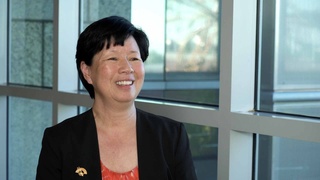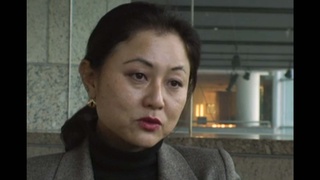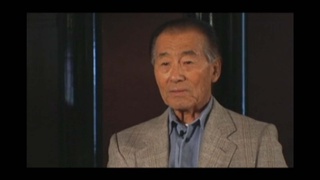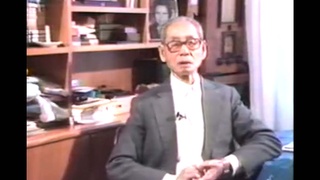Interviews
Marriage and Returning to US
In 1948, we were married in a little Methodist Church on the Ginza—just her father, Shizuko Naito, and I guess her father's friends or...there were only a small group of us at the wedding.
And nineteen...we lived in Fujisawa, I worked at NYK building in Tokyo and took the train everyday—commuted—from Fujisawa because her father gave us a room for ourself, which extended to the Japanese garden, it was a beautiful place and had a big pool with Japanese carp and beautiful goldfish and in 1950 I finally got permission to take my wife back to the U.S.
At that time, there were no Orientals allowed, in 1950, in America. So my father went to an alderman, greased his palm—for his connections in Washington—and there they passed a bill, I forget the name of it—the number, 7276 or something like that, that allowed her to come into the United States. And so in 1950, November, we left on the General Mann, it was a transport ship—army transport—and there was a storm just outside of Yokohama—again—in the winter, of course, and it followed us all the way to San Francisco, where we docked. And then we got on a train, and Hamako was very sea-sick and miserable, and we went to Solano Beach, where my aunt had my father buy a small place, so we would have a place to live.
Date: January 26, 2012
Location: California, US
Interviewer: John Esaki, Yoko Nishimura
Contributed by: Watase Media Arts Center, Japanese American National Museum
Explore More Videos

Fort Snelling
(b. 1921) Nisei veteran who served in the occupation of Japan

Attempts to sign up for military service
(1917 - 2004) Political activist

Traveling from Manila to Tokyo
(b. 1921) Nisei veteran who served in the occupation of Japan

Joined Japanese Imperial Army during the WWII (Spanish)
(b. 1929) Nisei Argentinean

Camp stories impact on her career
Sansei judge on the Superior Court of Los Angeles County in California

Concentration camp from a Japanese mother’s point of view (Japanese)
Shin-Issei from Gifu. Recently received U.S. citizenship

Meeting other Americans in jail
(1916-2010) draft resister, helped form the Heart Mountain Fair Play Committee


People with talent in the 100th infantry battalion
(1919 - 2006) World War II and Korean War veteran


Makegumi - Movement to regognize the defeat of Japan (Japanese)
A central figure for the “Makegumi” (defeatists)

Strictly American, but sympathize with Japan
(1919-2020) Member of the 1800th Engineering Battalion. Promoted Japan-U.S. trade while working for Honda's export division.

Not able to go to Manzanar on a furlough
(1919-2020) Member of the 1800th Engineering Battalion. Promoted Japan-U.S. trade while working for Honda's export division.

Enlisting in the U.S. Army (Japanese)
(1928 - 2008) Drafted into both the Japanese Imperial Army and the U.S. Army.

Father's Service in WWII
(b. 1930) Half Japanese and grew up in both Japan and the United States.
